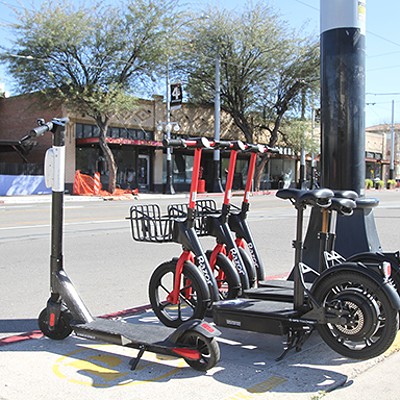At a public meeting last December attended by about 50 outraged citizens, ADOT planners presented three options for dealing with falling rocks at the pullout. To create enough space to catch rocks in ditches before they can roll onto the highway, each alternative proposed moving the highway away from a nearby hillside.
But the plan would require the destruction of trees which are home to a large variety of birds, including some rare species. According to Kevin Dahl, director of the Tucson Audubon Society, the Patagonia pullout "is one of the top 10 birding sites in the United States." Not only is it adjacent to Sonoita Creek and a Nature Conservancy sanctuary where 300 different kinds of birds are found; the pullout also provides an easy site from which to observe birds.
At the December meeting, attendees had plenty of questions. They asked for statistics documenting the extent of rock slides in the area, as well as inquiring about the department's efforts in deterring heavy truck traffic from the highway. Transportation officials had no answers for their questions that night. Given the lack of evidence that any change at the pullout was necessary, some citizens at the meeting suggested ADOT just forget the whole thing. Others proposed investing project funds and using the subsequent interest to pay someone to permanently live at the site to remove what few rocks ended up on the highway.
Department of Transportation officials were not amused. Since the December meeting, they've prepared additional information in anticipation of a second public meeting scheduled for next week.
According to ADOT officials, there have been numerous instances over the past several years where falling rocks have rolled onto the highway, but most of those cases were not documented. They cite the maintenance records of the work crew for the area as evidence of problems, along with the memory of local law-enforcement agents to back up the claim that falling rocks at the pullout is a potentially hazardous situation.
But maintenance records only list "Storm and Rock Patrol" work, not specific dangerous rockfall occurrences. ADOT also states that "no reported accidents have been caused by random rockfall" in the area at any time.
Sergeant Dave Aho of the Santa Cruz County Sheriff's Department did tell ADOT "that during monsoon season he'll observe rocks anywhere from grapefruit size to large boulders in the SR 82 roadway as frequent as every other day." He also "recalled several years ago an incident where a boulder the size of a Volkswagen Bug fell onto the SR 82 roadway."
Patagonia Town Marshall Jerry Morgan remembers things differently. He told ADOT that he had seen rocks on the highway ranging "from baseball size to grapefruit size" in the six years he has been in the area.
"I estimate I have gone thru this town (Patagonia) approximately 17,400 times," remembers Herb Wood, a United Parcel Service driver who uses the road regularly. "On only one occasion do I remember seeing a rock. This killer was about the size of my hand and I was actually able to drive around it without the government's assistance!"
Annie McGreevy, head of Friends of Scenic Route 82, finds it interesting that the Department of Transportation flatly refuses to do vibration studies on the impacts of heavy truck traffic on rockfall occurrences. She recalls that in 1994, then-Gov. Fife Symington promised to try to reduce the number of huge trucks using the highway as a bypass around Tucson. State officials later claimed it wasn't legally possible, even if it is done in other parts of the country.
So what is behind the Department of Tranportation's push to implement this rockfall containment project? Department officials insist that "measures must be taken to increase the safety for those traveling on SR 82."
To improve safety, at next week's meeting Department of Transporation officials will present five alternatives for the pullout. Two would install 29-foot "V" ditches to catch rolling rocks, two others would have 16-foot "V" ditches, and one would include a 10-foot trapezoid ditch.
All of these alternatives will require moving the highway various distances; cost estimates range from $1.2 to $1.7 million, plus $200,000 for design work. Department of Transportation officials will not be presenting an alternative that includes doing nothing.
After the meeting, Department of Transportation officials will review their options and make a final recommendation later this summer. Dahl suspects the outcome of the process will be preordained. With federal money available to pay for 95 percent of the construction costs, he suggests that the Department of Transportation officials want to spend it on the project, whether it is needed or not.
Dahl suggests there may be another reason for ADOT's failure to seriously attempt to reduce the amount of heavy truck traffic using the scenic highway: the rockfall containment project may just be one small step toward encouraging even more traffic to use the road.
Whatever ADOT's motivation, at next week's meeting the public will have an opportunity to comment on the five options for the pullout. If none of these are acceptable to those who prefer birds to boulders, Dahl anticipates legal action will be taken to stop the entire project.
The Public Information Meeting for the State Route 82 Rockfall Containment Project will be from 6 to 8 p.m. Wednesday, April 5, at Cady Hall, 342 Duquesne, in Patagonia.











